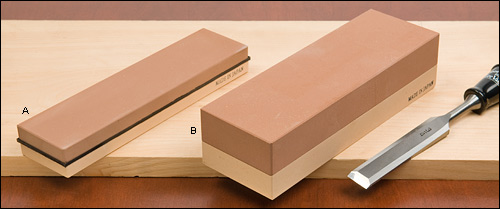Japanese waterstones
I got a Japanese waterstone for christmas. I’ve wanted for some time to learn how to sharpen an edge properly on a stone, rather than with one of those little sharpening jig things. There’s an old oilstone sitting in the basement somewhere but it always clogs extremely fast…from what I’ve heard, waterstones are generally faster and cleaner and fairly straightforward to use.
I soaked the stone for half an hour to get it properly loaded, and watched a couple of videos online to get the idea of the proper technique. With time you apparently develop a sense for how the blade is sliding on the stone and the sounds it makes to know if you’re working it properly, but at this point I’m only really able to tell by feeling the edge and trying to guess whether it got sharper or duller. 😛
So I sharpened a whole bunch of knives, starting off with some of the cheap old ones sitting in my toolbox to get the idea. Getting the angle right is critical, of course, and the required pressure was more than I expected. I think I did a decent job: I turned a completely dull and rusted knife that I found on the road into something that’ll cut a tomato, got my pocketknife sharp enough to slice paper like an X-Acto blade at the tip, and honed a Japanese carpenter’s knife into an edge sharp enough to shave with. Seriously. It’s pretty clear from that how the different grinds and steels affect the sharpness of the blade — the Japanese knife has the shallowest grind and is made of very hard, very brittle high-carbon steel, while the Found Object knife has a pretty steep grind and the blade is flexible, so it’s probably mild steel or something equally cheap. Of course that does mean that the Japanese knife is fragile, while the Found Object stands up to much more abuse. Always a tradeoff.
My sister says I look like a sociopath sitting at the kitchen table slowly sharpening a pile of knives one by one. But any boy scout can tell you that a sharp blade is safer than a dull one…and besides, who doesn’t like having nice tools?
